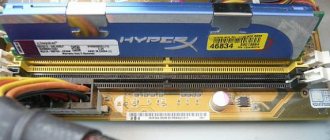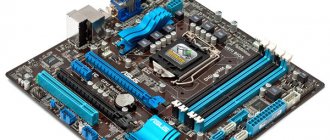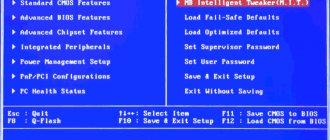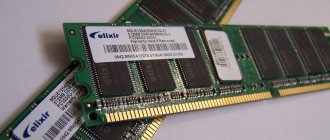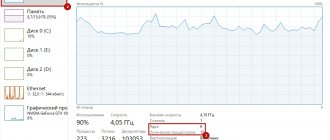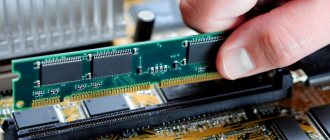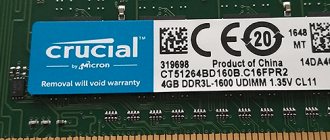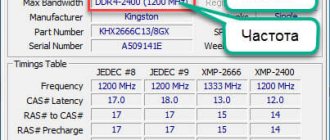Every computer or phone without exception must have RAM. Without it, not a single computer device will function normally. Replacing RAM is the first thing that comes to mind when you need to increase the power and speed of your computer. Replacing RAM is a very simple process that does not require any additional equipment. That is why many begin improving their computer with this element of the system unit. Of course, you can change the processor or video card and this will give a greater performance increase. But an untrained person is unlikely to be able to select and install a suitable processor himself. RAM is another matter. When purchasing it, you only need to know whether the memory is compatible with the motherboard. Let's figure out how to check compatibility.
Compatibility of motherboard and RAM
What is RAM
Let's start with what RAM is. Random access memory, or RAM (Random Access Memory) is a type of random access memory. It is a place for temporary storage of information with the help of which the software and the computer itself operate. RAM contains information that the processor must process. In RAM, information waits for its turn.
Physically, RAM is a small strip on which microcircuits are located. There are contacts on the bottom edge of the RAM; this side is where the memory is inserted into the motherboard. Some, especially expensive, RAM models are equipped with a metal cooling radiator and backlight.
RAM with heatsink
Interesting! RAM compares favorably with a hard drive in that the number of operations and its age have virtually no effect on durability. This means that high-quality RAM is a very reliable and durable device that will not fail for a long time. It is quite easy to break it by mechanical force, for example, if you insert it into the wrong slot.
Insert the RAM into the appropriate slot
Why do you need to check the compatibility of the motherboard and RAM?
It may seem that it doesn't matter what kind of RAM you put into the motherboard. It is not that simple. If you use the wrong RAM, the computer simply will not work. Otherwise, the RAM will not physically fit into the corresponding slot. If you buy the wrong memory stick, you will find yourself in a very unpleasant situation, because the RAM will either have to be replaced or sold. To avoid this situation, let's find out how to choose the right RAM stick.
What is the difference between RAM
Correct definition of RAM
In order to understand how to choose RAM and how to check its compatibility with the motherboard, you need to understand how different RAM sticks differ from each other. RAM differs in the following ways:
- memory type;
- manufacturer, a company that produces and sells a specific model;
- volume, the most important indicator, based on it, memory is selected;
- frequency.
Now let's take a closer look at each of these aspects. First of all, you should pay attention to the type of RAM. It could be: DDR2, DDR3 or DDR4. Of course, there are other types, but they are very outdated and there is no point in considering them now. All types of memory differ from each other not only in transfer speed, but also physically: different numbers of contacts and different locations of the “key”.
Types of RAM
If you have a motherboard that only supports DDR2 RAM standard, then under no circumstances should you insert other types of RAM into it. She will not physically enter there and will not work. Nevertheless, there are craftsmen who “modify” the RAM with a file or in any other way insert it into the wrong slot.
Manufacturer
Rating indicator of motherboard manufacturers
Motherboards are not picky about the RAM manufacturer. Choose any manufacturer you like.
Memory
Motherboard memory capacity
Motherboards have a maximum capacity limit of one module per slot. If you insert a module larger than the intended capacity, the memory will not function correctly or will not work at all.
Frequency
Motherboard frequency
An important indicator of compatibility. Each MP has a maximum frequency. While you're unlikely to get much more power by using faster RAM, faster RAM won't work with a motherboard that's too old for it. Perhaps the memory will work well at a lower frequency of the motherboard. But then there is no point in overpaying and buying fast RAM.
For laptops
The same thing, just enter the laptop model.
By the way, while I was writing the article, the Asus interface changed a little.
Once in the section with the motherboard, you can go to the specifications and there will be the supported RAM frequency and its type.
And, to find out compatibility with a specific RAM model, go to the support tab and support for memory modules and other devices.
Here you need to download the list, there are several of them, so don’t focus on just one.
The table will contain models. It is better to buy the one that is definitely on the list.
Compatibility of RAM from different manufacturers
ASRock
ASUSTeK (ASUS)
Address:
https://www.asus.com/ru/support/ We look for the required model in the search and click search. Next, click the tab list of supported processors
EliteGroup (ECS)
Foxconn
Address:
https://foxconn.ru/products/mb/ At the time of writing this article, support was not working. You can only view product characteristics.
Gigabyte (Giga-byte)
Address:
https://www.gigabyte.com/support-downloads/cpu-support.aspx Select a processor or motherboard. And a list of supported processors or motherboards will appear.
Intel
Address:
https://processormatch.intel.com Select motherboards or processors, select your product and a list of supported equipment will appear.
Micro-Star (MSI, Microstar)
In the search we write model, support - compatibility - CPU support
TYAN
Supermicro
On the left we select the chipset.
Biostar
Select the required board and look for CPU Support.
Compatibility check
It seems that choosing RAM is very difficult due to the large number of requirements. But in reality, everything is not so scary, because you can use several simple and convenient methods.
First method
Find out if your motherboard is compatible with the desired RAM on the manufacturer's website.
- To do this, you need to know the make and model of your motherboard. You can find out by opening the lid. On the motherboard, as a rule, you can see the name and model.
Motherboard brand and model
- Next, go to the manufacturer’s website. There you will find RAM that has been tested with your motherboard and is guaranteed to work correctly. If you do not find the desired RAM in this list, this does not mean that your memory will not work. This only means that at the time of the test the manufacturer did not have such RAM. If purchasing a specific memory is not important to you, then you can choose one of the already guaranteed proven models.
List of verified RAM models on the manufacturer's website
Second method
Find the motherboard box, paper instructions, or instructions on the store's website. In it you will find all the characteristics of the motherboard, including the characteristics of the RAM slots.
Instructions with motherboard characteristics
Third way
When purchasing RAM, contact a consultant at the store, he will help you choose memory based on your motherboard.
How to check RAM for errors
If you see irregularities in the operation of your computer and suspect that the culprit may be the RAM, then simply check it for errors. There are several ways to do this.
Method 1: Using a standard Windows utility
- Type the word “tool” in the search bar of the Start menu and find the memory verification utility there.
Method 2. Using Memtest86+
Memtest86+ is a free program for testing RAM for errors.
- You can download the program from the official website.
After this, you need to wait a bit until the installation is completed. Now there is a program image on your flash drive. Enter the BIOS and set the boot mode to boot from the drive.
On a note! If you have several RAM sticks installed, then run the scan for each of them one by one.
CPU and RAM compatibility
Selecting processor and RAM compatibility
The RAM control controller, in modern models, is installed directly into the processor. Now, when choosing memory, you also need to find out compatibility with the processor. Fortunately, processors are not so demanding on RAM and in most cases work correctly with most modules. But some points are worth paying attention to. For example, Clarkdale Core i3, Core i5-6XX, Celeron G1XXX, Pentium G6XXX do not work with 512 MB memory chips.
Compatibility of RAM sticks from different manufacturers and frequencies
PC owners may want to increase the amount of RAM by purchasing a new module. The question immediately arises in their mind: “Will the new dies work correctly with the old ones?” In theory everything should work, but in practice problems arise.
Adding new RAM to old
The fact is that there are a lot of manufacturers of RAM, but there are only a few manufacturers of chips for this memory. Chips from different manufacturers can be installed both on RAM from different manufacturers, and on different models of RAM from the same manufacturer. That is, in theory, you can buy the same RAM from the same manufacturer, with a difference of several months or years, and the new die will have chips from a completely different manufacturer. Such dies may well have a conflict and will not start.
Conflict screen with different RAM and chipset
On the other hand, you may be lucky and several dies with different chips from different manufacturers will work correctly. But memory differs not only in size and manufacturer, but also in frequency. RAM with different frequencies can work together. At the same time, they will operate at the frequency of the slowest RAM.
About memory module manufacturers
Many are sure that there are only a few RAM manufacturers selling them under different brands. The statement is only partly true. Indeed, RAM chips are produced by a small number of companies, and based on them, memory module manufacturers develop their own boards.
p, blockquote 5,0,1,0,0 –>
A similar situation is observed with graphics processors for video cards: they are produced only by NVIDIA and AMD, then dozens of manufacturers assemble devices based on them.
p, blockquote 6,0,0,0,0 –>
Although all components are built to standards, board specifications may vary due to design specifications. Moreover, chips from the same manufacturer from different batches with different production dates may also differ in characteristics (nowadays this is very rare).
p, blockquote 7,0,0,0,0 –>
